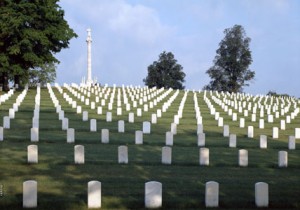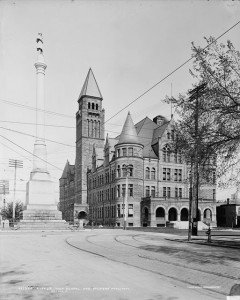Yesterday, my daughter and I had a mom-and-daughter afternoon and visited a local historical site neither of us had yet visited: the Paul Lawrence Dunbar State Memorial. Dunbar was a celebrated writer who was born in Dayton in 1872 (died in 1906) and is a significant literary figured not only for his work’s own sake, but because he was an African-American who wrote both in black dialect and in standard English.
Dunbar’s parents were both former slaves, and his father enlisted to serve the Union in the Civil War. Dunbar was always proud of his father’s military service, and his first poem was published when he was only sixteen! It’s particularly relevant today as we remember those who served and sacrificed their lives.
“Our Martyred Soldiers”
by Paul Laurence Dunbar (public domain)Dayton National Cemetery at the Veterans Affairs grounds
In homes all green, but cold in death,
Robbed of the blessed boon of breath—
Resting in peace from field and fray,
Our martyred soldiers sleeping lay.Beneath the dew, the rain, the snow,
They heed no more the bloody foe,
Their sleep is calm, to them alone
‘Tis giv’n to lie without a moan.The sun may shine in all his might—
They know no day, they know no night,
But wait a still more lasting ray,
The coming of eternal day.No longer marches break their rest,
Or passioned hate thrills through the breast,
They lie all clothed in calm repose,
All safe from shots of lurking foes.The grave’s a sacred place where none
Of earth may touch the sleeping one;
Where silence reigns, enthroned, sedate,
An angel guarding heaven’s gate.The wind may blow, the hail may fall,
But at the tomb is silence all;
Man finds no nobler place to pray,
Then o’er a martyr’s lifeless clay.Sleep on, ye soldiers, men of God,
A nation’s tears bedew the sod;
‘Tis but a short, short time till ye
Shall through the shining portals flee.And when this memory lost shall be,
We turn, oh Father, God, to thee!
Oh find in heaven some nobler thing
Then martyrs of which men can sing.
I’ll share some photos and more interesting facts we learned about Dunbar in future posts.
What are you doing this Memorial Day? Or, if you’re not in the U.S., does your country have a similar day of remembrance? Do you have a friend or family who served that you’d like to tell us about? Please feel free to do so in the comments!






